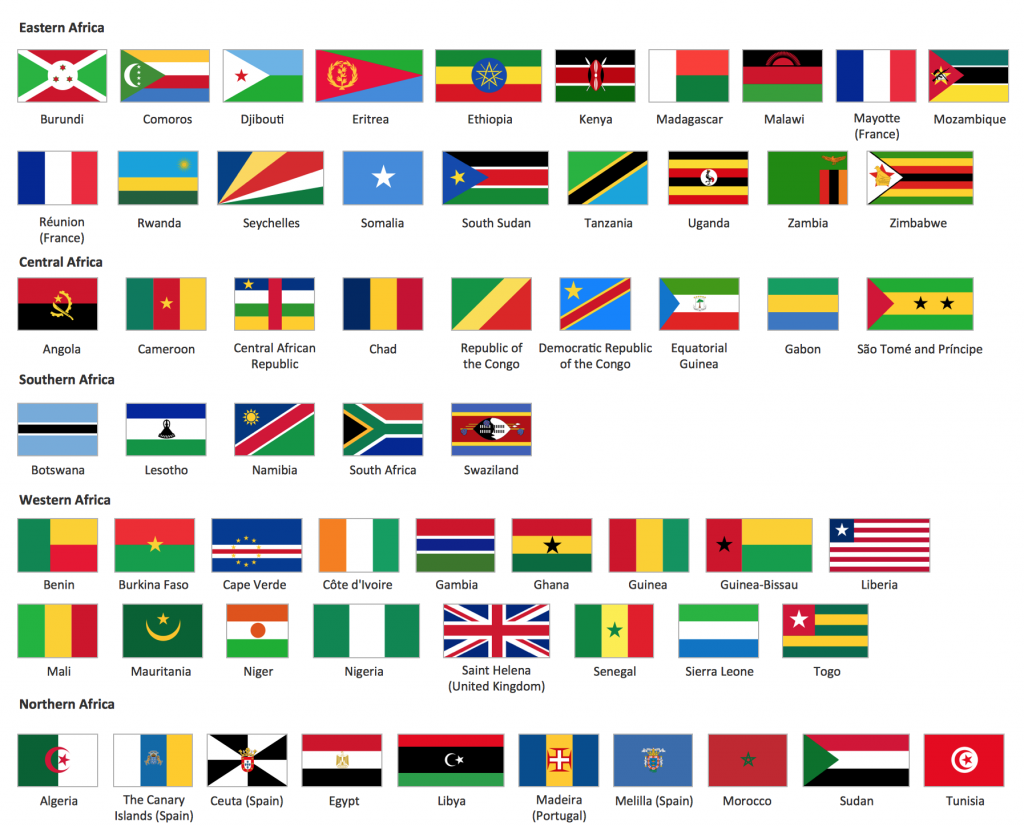Surrounded by water from all directions, Africa is a continent with clearly determined and absolutely accurate borders. In the north it is separated from Europe by the Mediterranean Sea, in the northeast, is separated from Asia by the Suez Canal and farther by the Red Sea. From the east and southeast it is surrounded by the Indian Ocean, from the west by the Atlantic Ocean.
The total number of independent states in Africa is 54. The transcontinental country in this region is Egypt, having also a small part of its territory in Asia, on the other side of the Suez Canal, but politically it is a member of the African Union.
Among the African countries, the biggest one is Algeria, occupying around 7% of the continent’s territory. And the smallest nation is the Seychelles, the worldwide famous luxurious beach holiday destination, occupying 115 islands stretching along the mainland’s eastern coast.
The colorful Morocco is in the first place among the most popular travel spots in this part of the world, the second place belongs to South Africa, followed by Egypt and Tunisia.
Approximate number of population in African Countries is 1,097,026,000
African Countries listed on Alphabetical Order
Africa has one of the most land masses on earth, covering 30.2 million square km (11.7 million sq mi) including adjacent islands. With this, Africa covers 6% of the Earth’s total surface area and 20.4 % of the world’s land area and is home to more than 1 billion people.
There are 54 African countries sharing this huge land mass. Most countries in Africa have seen a massive population growth with values doubling up in the past 50 years and these values are estimated to at least double by 2050 according to the latest United Nations projections.
In Africa today, 2 in every 3 people living in Africa are under 25 years of age (This number is 2 times the number in Europe). The population distribution of people in African countries is such that 32 inhabitants live in every square km and on the average, the Sub-Saharan Africa is more densely populated than the Latin America which has 28 inhabitants living in every square Km and it is estimated that Sub-Saharan Africa’s population density is going to increase to more than double where Latin America is today.
In most African countries, two-thirds of the population still live in rural areas although there is massive migration to the towns.
As at 1960, only the city of Johannesburg, had a population of more than one million people but not anymore since more than 40 African cities now have more 1 million people and if this rate continues, more than 50% of rural dwellers will migrate to the urban areas by 2030.
African Countries listed based on number of population
no |
Country |
Population |
Country Code |
Capital |
Population |
| 1 | Seychelles Island | 94,000 | 248 | Victoria | 25,000 |
| 2 | São Tomé and Príncipe | 194,000 | 239 | São Tomé | 43,400 |
| 3 | Cape Verde | 511,000 | 238 | Praia | 62,000 |
| 4 | Equatorial Guinea | 685,000 | 240 | Malabo | 35,000 |
| 5 | Comoros | 743,000 | 269 | Moroni | 19,000 |
| 6 | Djibouti | 918,000 | 253 | Djibouti | 62,000 |
| 7 | Swaziland | 1,077,000 | 268 | Mbabane | 41,000 |
| 8 | Mauritius | 1,273,000 | 230 | Port Louis | 145,000 |
| 9 | Guinea-Bissau | 1,699,000 | 245 | Bissau | 120,000 |
| 10 | Gambia | 1,794,000 | 220 | Banjul | 52,000 |
| 11 | Lesotho | 1,887,000 | 266 | Maseru | 14,000 |
| 12 | Botswana | 2,096,000 | 267 | Gaborone | 140,000 |
| 13 | Namibia | 2,160,000 | 264 | Windhoek | 148,000 |
| 14 | Gabon | 2,204,000 | 241 | Libreville | 57,000 |
| 15 | Mauritania | 3,461,000 | 222 | Nouakchott | 135,000 |
| 16 | Liberia | 3,881,000 | 231 | Monrovia | 430,000 |
| 17 | Republic of the Congo | 4,525,000 | 242 | Brazzaville | 620,000 |
| 18 | Eritrea | 4,980,000 | 291 | Asmara (Asmera) | 360,000 |
| 19 | Central African Republic | 5,217,000 | 236 | Bangui | 480,000 |
| 20 | Sierra Leone | 5,823,000 | 232 | Freetown | 48,000 |
| 21 | Libya | 6,323,000 | 218 | Tripoli | 570,000 |
| 22 | Togo | 6,675,000 | 228 | Lomé | 160,000 |
| 23 | Burundi | 9,023,000 | 257 | Bujumbura | 240,000 |
| 24 | Somalia | 9,662,000 | 252 | Mogadishu | 260,000 |
| 25 | Republic of Benin | 9,742,000 | 229 | Porto-Novo | 185,000 |
| 26 | South Sudan | 10,334,000 | 211 | Juba | 250,000 |
| 27 | Rwanda | 10,780,000 | 250 | Kigali | 118,000 |
| 28 | Tunisia | 10,889,000 | 216 | Tunis | 620,000 |
| 29 | Guinea | 11,861,000 | 224 | Conakry | 770,000 |
| 30 | Chad | 12,948,000 | 235 | N’Djamena | 190,000 |
| 31 | Zimbabwe | 13,098,000 | 263 | Harare | 1,200,000 |
| 32 | Senegal | 13,567,000 | 221 | Dakar | 165,000 |
| 33 | Zambia | 14,129,000 | 260 | Lusaka | 1,000,000 |
| 34 | Malawi | 15,316,000 | 265 | Lilongwe | 250,000 |
| 35 | Mali | 16,678,000 | 223 | Bamako | 700,000 |
| 36 | Niger Republic | 16,850,000 | 227 | Niamey | 250,000 |
| 37 | Burkina Faso | 17,338,000 | 226 | Ouagadougou | 650,000 |
| 38 | Angola | 21,256,000 | 244 | Luanda | 470,000 |
| 39 | Cameroon | 21,331,000 | 237 | Yaoundé | 660,000 |
| 40 | Madagascar | 21,852,000 | 261 | Antananarivo | 370,000 |
| 41 | Ivory Coast | 24,261,000 | 225 | Yamoussoukro | 110,000 |
| 42 | Mozambique | 24,491,000 | 258 | Maputo | 900,000 |
| 43 | Ghana | 26,441,000 | 233 | Accra | 600,000 |
| 44 | Morocco | 32,950,000 | 212 | Rabat | 1,230,000 |
| 45 | Sudan | 35,150,000 | 249 | Khartoum | 930,000 |
| 46 | Uganda | 35,363,000 | 256 | Kampala | 330,000 |
| 47 | Algeria | 38,295,000 | 213 | Algiers | 1,600,000 |
| 48 | Kenya | 43,291,000 | 254 | Nairobi | 1,200,000 |
| 49 | Tanzania | 45,950,000 | 255 | Dar es Salaam | 1,100,000 |
| 50 | South Africa | 53,076,000 | 27 | Cape Town | 1,600,000 |
| 51 | Democratic Republic of the Congo | 74,618,000 | 243 | Kinshasa | 2,800,000 |
| 52 | Egypt | 84,605,000 | 20 | Cairo | 6,800,000 |
| 53 | Ethiopia | 86,565,000 | 251 | Addis Ababa | 2,400,000 |
| 54 | Nigeria | 177,096,000 | 234 | Abuja | 300,000 |













Zimbabwe is in southern Africa
very informative
it was a good help in my research about Africa